#187: Phylloporus rhodoxanthus, the Gilled Bolete
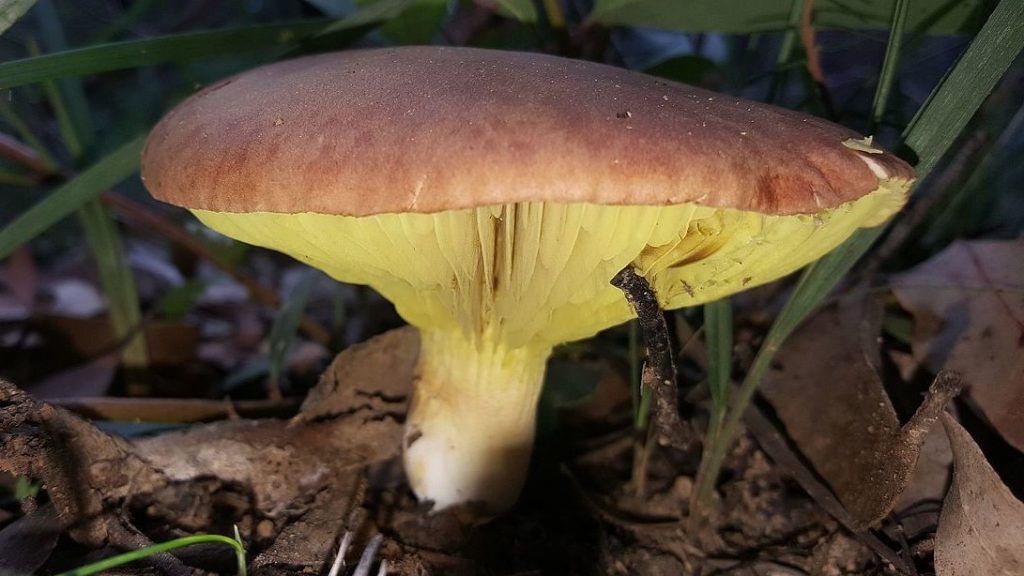
Phylloporus rhodoxanthus is a bolete that has decided to form gills instead of pores. Photo by Casliber [CC BY-SA 4.0], via Wikimedia Commons (cropped).
Description
The first time I found the Gilled Bolete on my own, it confused me for a long time. When I found it, my first reaction was, “There’s something odd about this mushroom’s gills.” Unfortunately, I didn’t have enough time to thoroughly examine the mushroom, so I just snapped a couple of pictures and ran off. This meant that I had to try to identify it later using only those pictures (a difficult endeavor for any mushroom). For a while, I was stumped. In my head, the mushroom just didn’t match any morphological group of agarics. It also wouldn’t key out with any agarics in my field guide. Sometime later, I was flipping through my field guide to find another mushroom and came across the page for P. rhodoxanthus. Finally, I had figured out why the mushroom didn’t fit anywhere: it wasn’t an agaric, it was a bolete with gills!
Most field guides key out the Gilled Bolete with the boletes. This can make it difficult for people just starting out, but makes sense from a taxonomic and morphological (when the gills are ignored) standpoint. The mushroom’s stature is most obvious morphological clue that it is a bolete: its size and the ratio of its pileus to its stipe are just what you would expect from a bolete.1 Another major indicator that you should consult the bolete section of your field guide is its spore print: P. rhodoxanthus has a yellowish to brownish-yellow spore print.1,2 Yellow is a rare spore print color in true agarics; most of them with yellow-toned spores either are pale yellow or lighter or are yellowish-brown or darker.
The pileus of P. rhodoxanthus is perhaps the most bolete-like part of the mushroom. It is 2-10cm across, circular, and starts out convex but becomes flattish by maturity.1–3 To me, the pileus appears thicker than I would expect for most agarics and develops wrinkles or lobes around the edge that are reminiscent of the way boletes develop. As the mushroom ages and dries out, the cap often develops irregular cracks that expose the pale flesh below, in much the same way that boletes do. The pileus is variable in color. It is most distinctive when red, but it can be anywhere from red to brown to light brown, sometimes with shades of olive.1–3
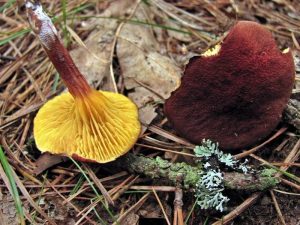
The Gilled Bolete typically has a reddish pileus and yellow, decurrent gills. Photo by Bob (Bobzimmer) [CC BY-SA 3.0], via Wikimedia Commons
The stipe of the Gilled Bolete is 2-9cm long and 0.5-1.5cm wide. It is roughly the same width for its entire length, although it is usually a bit wider at the top and a bit narrower at the bottom. The stipe is colored yellowish and is a bit darker than the gills. You usually find some flecks of reddish color in the stipe; sometimes the flecks turn a significant portion of the stipe reddish. Dig up the whole base and you will find yellow threads of mycelium attached to the mushroom just under the soil surface.1–3
Like the boletes, P. rhodoxanthus is ectomycorrhizal. It forms relationships with hardwoods, most often with oaks and beeches. The mushrooms appear from summer through fall. Look for them on the ground in hardwood forests of North America; they often fruit alone but there may be a few in a small area.1,2
Edibility
P. rhodoxanthus is considered edible, although I don’t know anyone who goes out of their way to eat this mushroom. Additionally, you usually find only a few mushrooms at once, so there is rarely enough to make a dish.3 The ones I find are typically buggy, dirty, dried up, or afflicted with some other condition that makes them not very appetizing. If you want to try these mushrooms, expect to do a fair amount of cleaning beforehand.
Similar Species
There are actually several species of Phylloporus in North America, although mycologists cannot agree on how many. The one described above is usually designated P. rhodoxanthus spp. americanus to distinguish it from the subspecies P. rhodoxanthus spp. pelletieri, which stains blue when bruised. P. pelletieri is the species that is most common in Eurasia. It is occasionally found in North America and can be distinguished from P. rhodoxanthus by its yellow cap and attached gills that only slightly run down the stipe. The species P. leucomycelinus grows in eastern North America; the white mycelial threads at the base of its stipe are the only visible difference between it and P. rhodoxanthus spp. americanus. P. arenicola is a rare species found on the West Coast under pines in sandy soil. Its gills are particularly well-developed for the genus and usually withdraw slightly from the stipe just before they meet it. P. boletinoides has the least developed gills of the genus. Cross-veins are abundant in that species and nearly make the mushroom look like it has pores (‘boletinoid’).2,4
Taxonomy
Even the scientific name of this mushroom cannot decide whether it is an agaric or bolete. The genus name Phylloporus is composed of the words phyllus, meaning ‘gill’,* and porus, obviously meaning ‘pore’.5** So where does this mushroom actually belong?
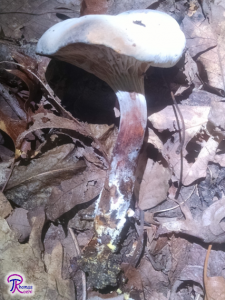
P. rhodoxanthus parasitized by Hypomyces chrysospermus, which attacks only mushrooms from the bolete lineage.
Originally, mycologists thought the Gilled Bolete represented a transitional stage that was left behind when the true agarics diverged from the pored mushrooms.6 However, this idea never had much support. For one, the microscopic features of P. rhodoxanthus clearly linked it with the boletes;4 if the hypothesis were correct, the Gilled Bolete’s microscopic features should have been intermediate between the boletes and core agarics. Another piece of evidence against the hypothesis is the fact that P. rhodoxanthus can be parasitized by the fungus Hypomyces chrysospermus. H. chrysospermus (commonly known as “the Bolete Eater,” FFF#158) grows only on mushrooms related to boletes. It can parasitize some mushrooms from a few true agaric lineages, but – like Phylloporus – all those lineages are descended from the bolete group (Boletales) and not the core agaric group (Agaricales).
Using DNA evidence, mycologists can definitively say that P. rhodoxanthus is not related to the core agarics. The main bolete and main agaric linages diverged a long time ago; much more recently, Phylloporus split from the core group of boletes. Since the closest relatives of Phylloporus are normal boletes with pores, the group represents an independent acquisition of gills and is yet another example of convergent evolution in kingdom Fungi.6
However, the original hypothesis that P. rhodoxanthus represents a trasitional stage might not be completely incorrect. If evolution continues to select for traits characteristic of gilled mushrooms, Phylloporus could become considered a true agaric genus sometime in the distant future. Today, the genus is therefore a useful snapshot of the evolutionary process that other agaric lineages within the Boletales are likely to have followed.
| Kingdom | Fungi |
| Division | Basidiomycota |
| Subdivision | Agaricomycotina |
| Class | Agaricomycetes |
| Subclass | Agaricomycetidae |
| Order | Boletales |
| Family | Boletaceae |
| Genus | Phylloporus |
| Species | Phylloporus rhodoxanthus (Schwein.) Bers.7 |
* Actually, phyllus means ‘leaf’, but it refers to gills when used in names of agarics.5
** As a side note, the specific epithet rhodoxanthus is composed of rhodon, meaning ‘rose-colored’, and xanthos, meaning ‘yellow’. This is apparently a reference to the Gilled Bolete’s color scheme.5,8
This post does not contain enough information to positively identify any mushroom. When collecting for the table, always use a local field guide to identify your mushrooms down to species. If you need a quality, free field guide to North American mushrooms, I recommend Michael Kuo’s MushroomExpert.com. Remember: when in doubt, throw it out!
See Further:
http://www.mushroomexpert.com/phylloporus_rhodoxanthus.html
http://www.mushroomexpert.com/phylloporus.html
https://blog.mycology.cornell.edu/2006/12/01/paxillus-a-gilled-bolete/
Citations
- Kuo, M. Phylloporus rhodoxanthus: The ‘Gilled Bolete’. MushroomExpert.Com (2005). Available at: http://www.mushroomexpert.com/phylloporus_rhodoxanthus.html. (Accessed: 12th May 2017)
- Labbé, R. Phylloporus rhodoxanthus / Phyllopore à lames dorées. Champignons du Québec (2014). Available at: http://www.mycoquebec.org. (Accessed: 12th May 2017)
- Miller, O. K. & Miller, H. North American mushrooms: a field guide to edible and inedible fungi. (Falcon Guide, 2006).
- Kuo, M. The Genus Phylloporus. MushroomExpert.Com (2005). Available at: http://www.mushroomexpert.com/phylloporus.html. (Accessed: 12th May 2017)
- List of Latin and Greek words commonly used in systematic names. Wikipedia (2017).
- Phylloporus, a gilled bolete. Cornell Mushroom Blog (2006).
- Phylloporus rhodoxanthus. Mycobank Available at: http://www.mycobank.org/Biolomics.aspx?Table=Mycobank&Rec=210475&Fields=All. (Accessed: 12th May 2017)
- rhodo-. (2017). Available at: https://en.wiktionary.org/wiki/rhodo-. (Accessed: 12th May 2017)

![#070: Ganoderma applanatum, The Artist’s Conk [Archived]](https://www.fungusfactfriday.com/wp-content/themes/hueman/assets/front/img/thumb-medium-empty.png)
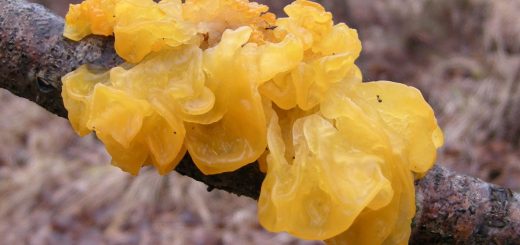





![#011: Characteristics of Kingdom Fungi [Archived]](https://www.fungusfactfriday.com/wp-content/themes/hueman/assets/front/img/thumb-small-empty.png)

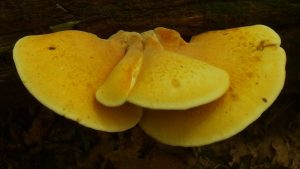

3 Responses
[…] “Gilled Boletes” (Phylloporus spp., FFF#187) can also be attacked by H. chrysospermus. As I have been told, this fact was significant for […]
[…] among boletes,8 which hints at the taxonomic relationships of Paxillus. Phylloporus mushrooms (FFF#187) produce gills that are thick, yellow, and have a wax-like texture. This distinctive combination is […]
[…] some mushrooms with gills that are not quite so well formed. For example, Phylloporus rhodoxanthus (FFF#187) and Lenzites betulina (FFF#168) are known as the “Gilled Bolete” and the “Gilled […]